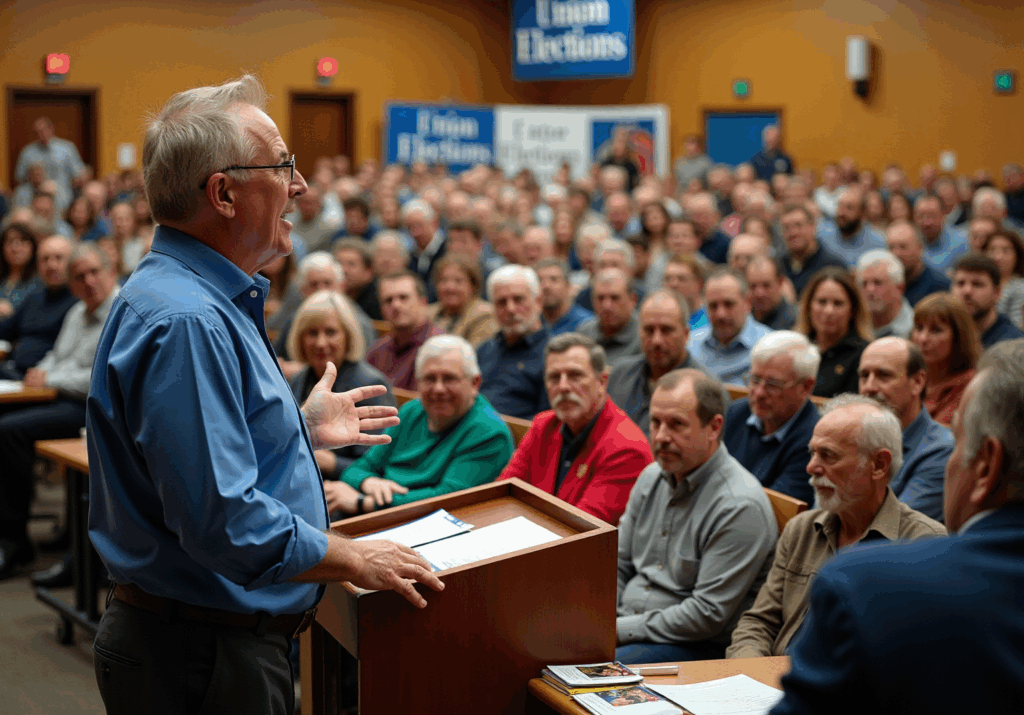Overview
An incumbent candidate refers to an individual currently in office who is seeking re-election. These candidates often enjoy distinct advantages, such as name recognition and established relationships, which significantly contribute to their high re-election rates. Understanding the dynamics of incumbency is essential for union members, as it directly influences electoral outcomes and the accountability of leadership within labor organizations. By grasping these concepts, union leaders can better navigate the electoral landscape and advocate for effective leadership accountability.
Introduction
Understanding the role of an incumbent candidate is essential in navigating the complexities of electoral dynamics, particularly within labor unions. Incumbents, those currently in office seeking re-election, often enjoy significant advantages, such as established relationships, name recognition, and a proven track record. These factors contribute to impressive re-election rates. However, this advantage can also lead to complacency, stifling the emergence of new leadership and raising critical questions about accountability and representation.
How can union members effectively evaluate incumbent candidates? This evaluation is crucial to ensure that their leadership aligns with evolving priorities and fosters a culture of responsiveness. By critically assessing the strengths and weaknesses of incumbents, union members can promote a leadership that is both accountable and representative of their interests. Engaging in this process not only enhances the democratic nature of union leadership but also ensures that the voices of all members are heard and considered.
Define Incumbent Candidate: Meaning and Role
What is an incumbent candidate? It is an individual who is currently holding a specific office or position and is seeking re-election to that same role. In the context of labor organizations, this includes officers or representatives who are pursuing another term. To understand what is an incumbent candidate, it’s important to note that they typically enjoy significant advantages over challengers, such as established name recognition, a proven record of service, and existing relationships with constituents. These factors lead to what is an incumbent candidate securing re-election at rates that surpass 90% in congressional contests, a trend that is also reflected in labor votes. The familiarity and trust developed over time can significantly affect voting results, making it essential for organization participants to understand what is an incumbent candidate and the implications of incumbency when involved in the electoral process.
Furthermore, Votem’s groundbreaking online voting solutions enhance accessibility, security, and transparency, enabling union members to engage more actively in polls. Votem’s ensure that every vote is counted accurately, reinforcing trust in the electoral system. Comprehending the financial environment is also crucial, as established players often possess access to greater funding and resources, which can further improve their chances of success. However, those in office may also face challenges such as political scandals or shifts in public sentiment that could jeopardize their re-election. Recognizing these dynamics, alongside the transparent and verifiable electoral processes supported by Votem, empowers members to make informed decisions and actively participate in shaping their leadership.
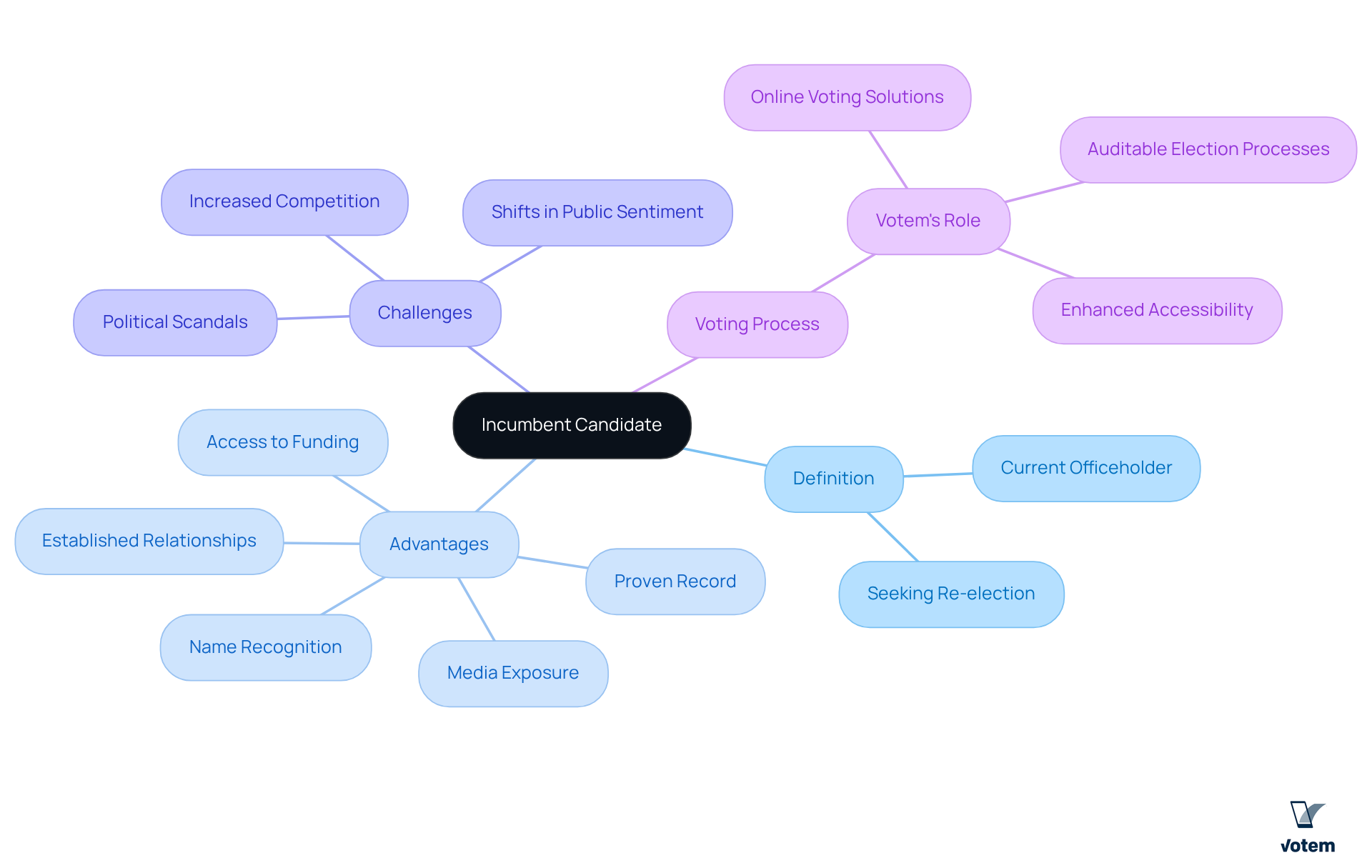
Explore the Historical Context of Incumbency
The concept of incumbency has deep historical roots, tracing back to the establishment of formal political systems. In numerous democratic societies, what is an incumbent candidate refers to those currently in position who have been favored due to their established presence and experience in office. Historically, officeholders have enjoyed various advantages, such as access to resources, media coverage, and established voter bases. Statistics reveal that over the past twenty years, the mean reelection rate for U.S. House members exceeds 94 percent, with the lowest rate being 85 percent. This underscores the stability of what is an incumbent candidate and its implications for electoral competition.
This trend is reflected in labor votes, where current officeholders utilize their past successes and established supporter groups to ensure re-election. For instance, in the context of elections, what is an incumbent candidate typically face less competition, as many challengers drop out, often due to party-affiliated candidates sharing the incumbent’s political orientation. Grasping this context is essential for group participants as they assess candidates during elections, especially concerning accountability and representation. The evolution of incumbency in labor organizations reflects broader democratic trends, where the advantages of incumbency have persisted, shaping the dynamics of leadership and governance within these entities.
As noted by OpenSecrets, ‘Few things in life are more predictable than the chances of a current member of the U.S. House of Representatives winning reelection.’ This statement highlights the entrenched nature of incumbency. Understanding this phenomenon is crucial for union leadership as they and strive for effective representation.
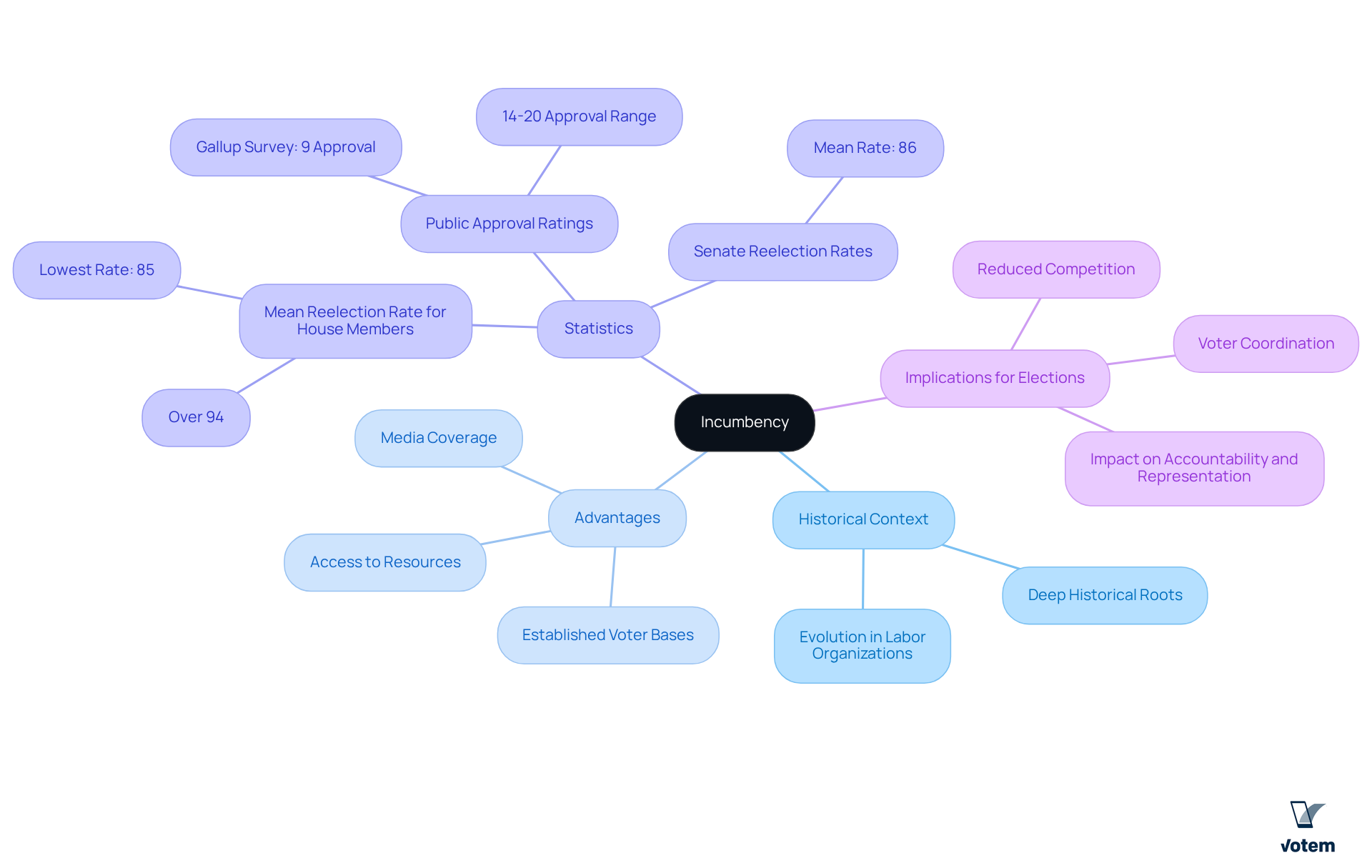
Examine Examples of Incumbent Candidates in Politics
Understanding what is an is essential as they play a crucial role in shaping electoral outcomes across various organizational structures, including unions. In the context of the U.S. Congress, current officeholders enjoy impressive re-election rates, often surpassing 90%. For instance, 94% of current officeholders who sought re-election succeeded in 2022, and this trend continued with a 95% victory rate in 2024. This phenomenon is largely attributed to their established networks and their ability to effectively communicate legislative achievements.
Furthermore, in collective votes, current officeholders leverage their previous terms to their advantage. Numerous labor leaders have successfully campaigned for re-election by highlighting their commitment to championing workers’ rights and enhancing working conditions. Such instances underscore the considerable impact of holding office in labor elections and emphasize the necessity for participants to critically evaluate what is an incumbent candidate and their performance and contributions.
Significantly, 43% of Democrats believe that most Congress members merit re-election, reflecting a broader sentiment that can also be observed in labor contexts. The elevated re-election rates of incumbent leaders demonstrate their effectiveness in addressing the needs of their constituents, reinforcing the significance of their roles within the organizational structure. As such, it is essential for union leadership to recognize these dynamics and engage in informed decision-making regarding candidate evaluations.
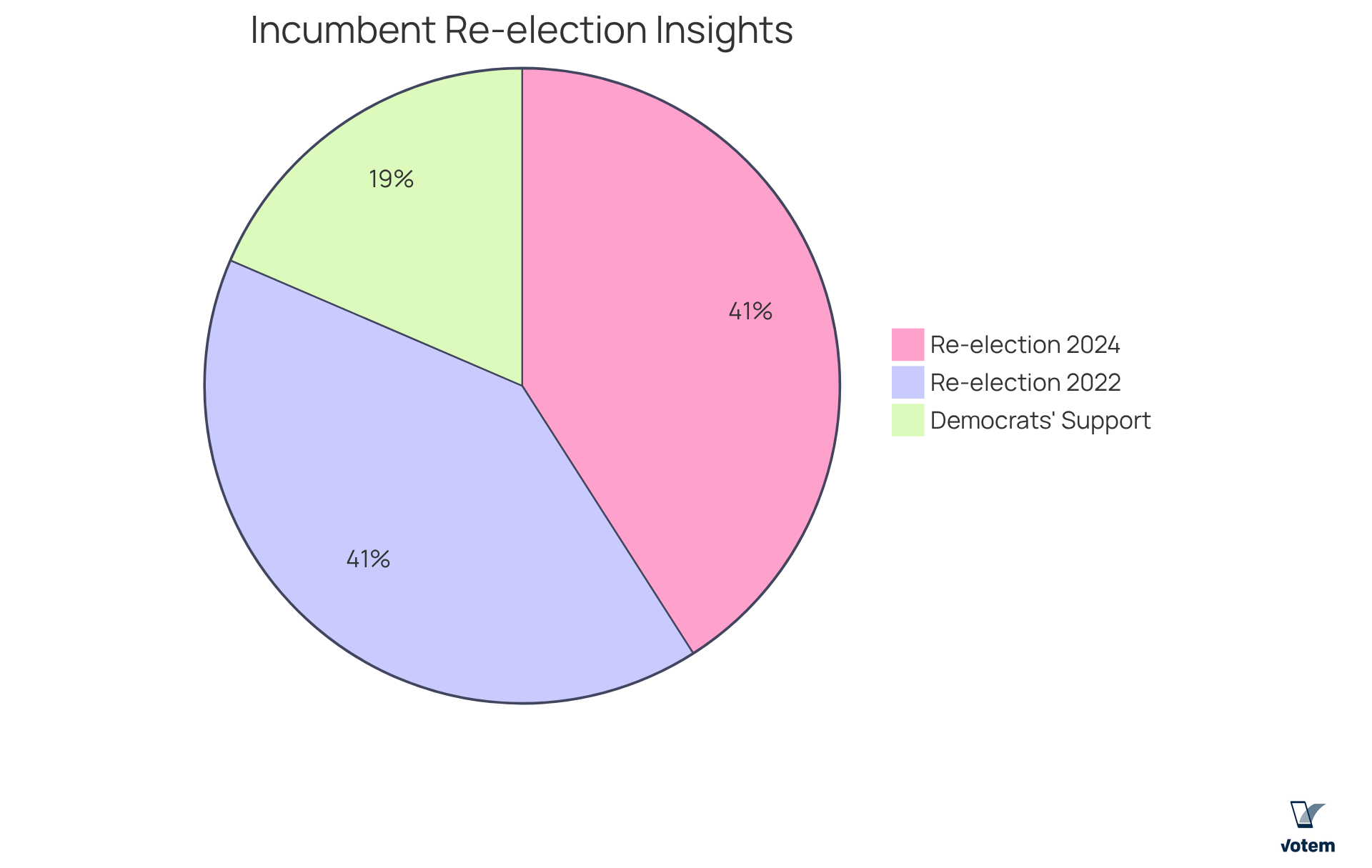
The Impact of Incumbency on Union Elections
In collective elections, the influence of incumbency is significant. Incumbent union leaders typically cultivate strong relationships with members, fostering loyalty and trust. However, this established support can lead to complacency, where those in power may assume their position is secure and overlook the evolving needs of their constituents.
Research shows that a 10-percentage point rise in voter turnout correlates with a 3.4 percentage point increase in vote shares for current officeholders. This indicates that in competitive settings. Furthermore, the presence of current members may discourage potential contenders, hindering innovation and essential transformation within the organization.
For instance, a study of municipal elections revealed that challengers supported by labor organizations are expected to expand the public sector size after the election, underscoring the considerable advantage that endorsements can offer to challengers.
It is essential for representatives to critically assess the performance of current officials, ensuring that their leadership aligns with the present priorities of the group. Engaging in open discussions about what is an incumbent candidate not only empowers members but also fosters a culture of accountability and responsiveness in union leadership.
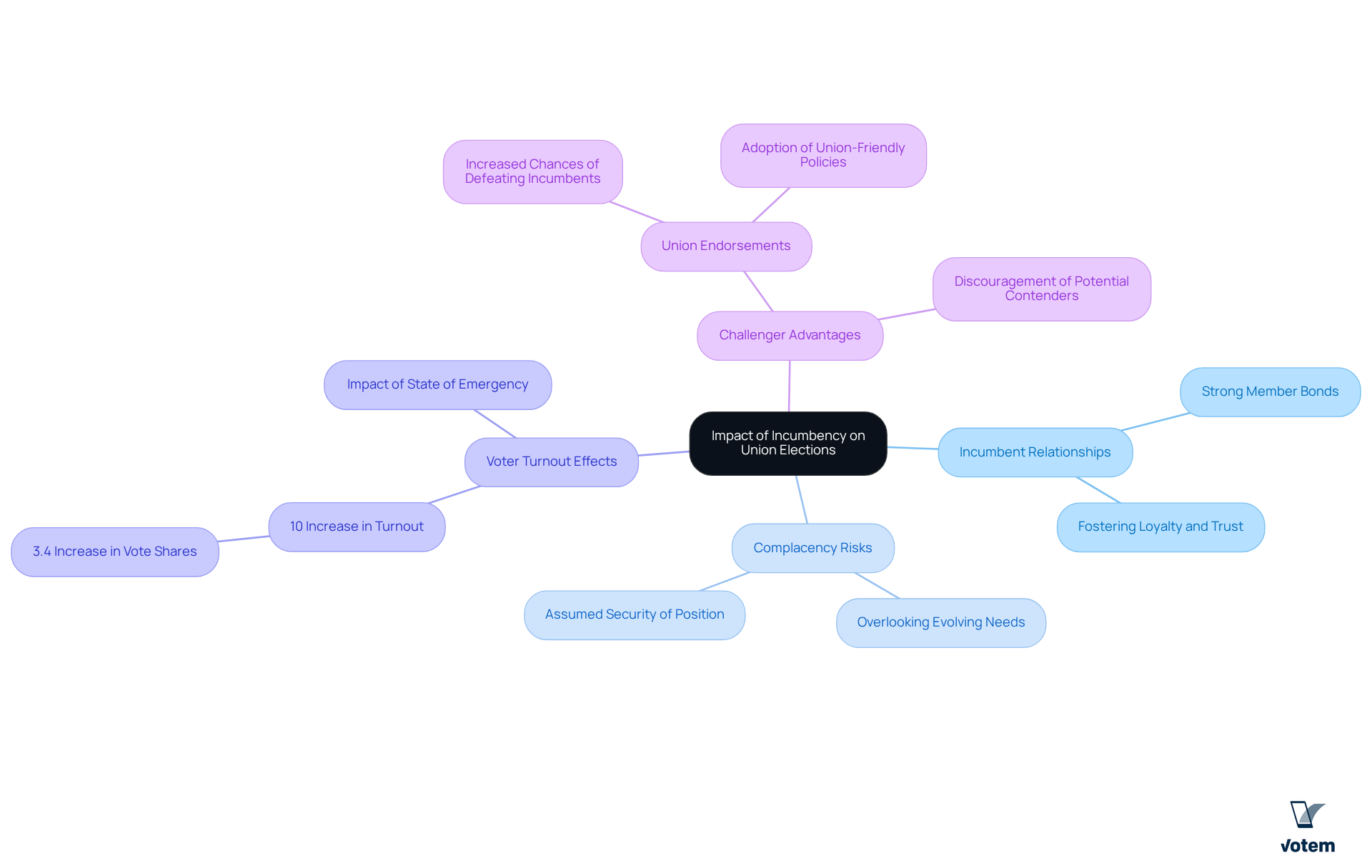
Conclusion
Understanding the role of an incumbent candidate is crucial for grasping the dynamics of electoral processes, particularly within unions. An incumbent candidate refers to individuals currently in office who seek re-election, benefitting from advantages such as name recognition, established relationships, and a proven track record. This familiarity often translates into high re-election rates, underscoring the significance of incumbency in shaping leadership within labor organizations.
Key insights reveal that incumbents not only enjoy substantial support due to their past achievements but also face challenges that can threaten their positions, such as shifts in public sentiment or political scandals. The historical context shows that incumbency has long been a dominant force in elections, with statistics indicating that re-election rates for incumbents in various political spheres remain impressively high. Furthermore, the impact of incumbency on union elections emphasizes the importance of accountability and responsiveness among leaders, urging members to critically assess their representatives’ performance.
Ultimately, recognizing the implications of incumbency empowers union members to engage more actively in the electoral process. By understanding the advantages and challenges faced by incumbent candidates, union participants can make informed decisions that reflect their needs and aspirations, fostering a culture of accountability and effective representation. Engaging with this knowledge not only enhances participation in union elections but also strengthens the democratic foundations of labor organizations.
Frequently Asked Questions
What is an incumbent candidate?
An incumbent candidate is an individual who currently holds a specific office or position and is seeking re-election to that same role.
What advantages do incumbent candidates have over challengers?
Incumbent candidates typically enjoy significant advantages such as established name recognition, a proven record of service, and existing relationships with constituents.
What is the re-election rate for incumbent candidates in congressional contests?
Incumbent candidates secure re-election at rates that surpass 90% in congressional contests.
How does incumbency affect voting results?
The familiarity and trust developed over time by incumbent candidates can significantly affect voting results, making it essential for voters to understand the implications of incumbency.
What role does Votem play in the electoral process for union members?
Votem provides groundbreaking online voting solutions that enhance accessibility, security, and transparency, enabling union members to engage more actively in polls.
How does Votem ensure the integrity of the election process?
Votem’s auditable election processes ensure that every vote is counted accurately, reinforcing trust in the electoral system.
What financial advantages do incumbent candidates often have?
Established incumbent candidates often have access to greater funding and resources, which can improve their chances of success.
What challenges might incumbent candidates face during re-election?
Incumbent candidates may face challenges such as political scandals or shifts in public sentiment that could jeopardize their re-election.
Why is it important for organization participants to understand incumbency?
Understanding incumbency dynamics empowers organization participants to make informed decisions and actively participate in shaping their leadership.
List of Sources
- Define Incumbent Candidate: Meaning and Role
- Why do incumbents have such a big advantage in elections? (https://wfyi.org/news/articles/why-do-incumbents-have-such-a-big-advantage-in-elections)
- Incumbents – (AP US Government) – Vocab, Definition, Explanations | Fiveable (https://fiveable.me/key-terms/ap-gov/incumbents)
- Incumbent Advantage (https://opensecrets.org/elections-overview/incumbent-advantage)
- Incumbency Performance in State Elections – The Council of State Governments (https://csg.org/2022/11/16/incumbency-performance-in-state-elections)
- Explore the Historical Context of Incumbency
- Incumbents have the upper hand in elections – coordination failures give them a further advantage (https://cepr.org/voxeu/columns/incumbents-have-upper-hand-elections-coordination-failures-give-them-further)
- Chapter 55: The Advantages of Incumbency – Attenuated Democracy (https://slcc.pressbooks.pub/attenuateddemocracy/chapter/chapter-55)
- Reelection Rates Over the Years (https://opensecrets.org/elections-overview/reelection-rates)
- The ‘super year’ of elections has been super bad for incumbents as voters punish them in droves (https://apnews.com/article/global-elections-2024-incumbents-defeated-c80fbd4e667de86fe08aac025b333f95)
- Incumbent Advantage (https://opensecrets.org/elections-overview/incumbent-advantage)
- Examine Examples of Incumbent Candidates in Politics
- Support for Congressional Incumbents Is Highest Since 2012 (https://news.gallup.com/poll/286316/support-congressional-incumbents-highest-2012.aspx)
- Incumbent politicians enjoy record reelection in an aging Congress – OpenSecrets News (https://opensecrets.org/news/2023/10/incumbent-politicians-enjoy-record-reelection-in-aging-congress)
- 95% of incumbents won re-election – Ballotpedia News (https://news.ballotpedia.org/2024/11/25/95-of-incumbents-won-re-election)
- Election results, 2024: Incumbent win rates by state (https://ballotpedia.org/Election_results,_2024:_Incumbent_win_rates_by_state)
- The Impact of Incumbency on Union Elections
- Two large labor union leaders leave DNC over disagreements (https://cbsnews.com/news/dnc-union-leaders-leave)
- The impact of unions on municipal elections and urban fiscal policies (https://sciencedirect.com/science/article/abs/pii/S0304393213000573)
- Higher turnout increases incumbency advantages: Evidence from mayoral elections (https://onlinelibrary.wiley.com/doi/10.1111/ecpo.12226)
- This Labor Leader Who Nearly Unseated a GOP Senator Wants More Working-Class Candidates to Run (https://inthesetimes.com/article/labor-union-working-class-dan-osborn-nebraska)

